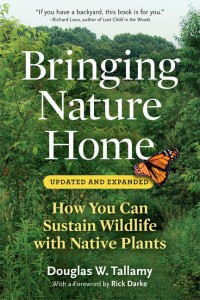 I am currently teaching an Urban Ecology course at Rosemont College in Philadelphia. One of the texts I selected for my students is Douglas Tallamy’s Bringing Nature Home (Timber Press, 2007). I really enjoyed this book, and so did my students–who were non-science majors most of which didn’t know anything about native plants, insects, or birds–the starring attractions of Bringing Nature Home.
I am currently teaching an Urban Ecology course at Rosemont College in Philadelphia. One of the texts I selected for my students is Douglas Tallamy’s Bringing Nature Home (Timber Press, 2007). I really enjoyed this book, and so did my students–who were non-science majors most of which didn’t know anything about native plants, insects, or birds–the starring attractions of Bringing Nature Home.
Tallamay, professor and chair of the Department of Entomology and Wildlife Ecology at the University of Delaware, has written Bringing Nature Home as both a unique book that is both manifesto as well as celebration and review of the role that native and invasive plants play in our backyards and neighborhoods. By showing the relationship between plants, bugs, and birds, Tallamay really does bring nature home in very specific and compelling ways. It is one thing to know theoretically that birds depend on bugs that depend on native plants. It is another thing to show us these links over and over with specific, sparkling and lucid writing as well as fantastic color photos of exotic-looking but very much native bugs chomping down on native plants.
I’m usually not a big caterpillar fan. In fact, I most like watching caterpillars when they are getting slammed against a limb by a migratory songbird. But I was so engaged by Bringing Nature Home that I wanted to head out immediately to my backyard to see if I could find these critters crawling around in my own yard. But since it is the middle of winter, all I could do was start scheming about what additional native plants I needed to pick up at a nursery this spring to attract these bizarre-looking critters to the yard.
Fortunately, Tallamy makes this easy as well, by providing lists of readily accessible native plants that serve as bug (and eventually, bird) food for each region of the country, as well as a list of the butterflies and other insects that depend on each tree, shrub, or flower.
For those curious about all of these bugs, Bringing Nature Home includes a section on each order of insects commonly found munching on native plants that includes amazing color photos as well as a summary of relevant life history information.
Bringing Nature Home will rock your world. Or rather, it will whisk you away into worlds you didn’t know even exist. Worlds that you can create in your own yard, and worlds that will help maintain the traditional cycles of nature that need our help to persist in a world dominated more and more by people and our less-than wildlife-friendly urban landscapes. I can’t recommend this book highly enough. A must read for anyone interested in nature, large or small, wild or tame!
(Review based on complimentary review copy obtained from Timber Press)
